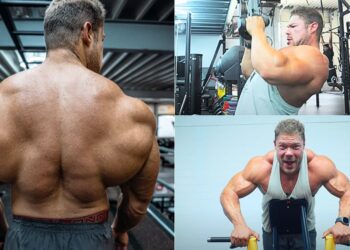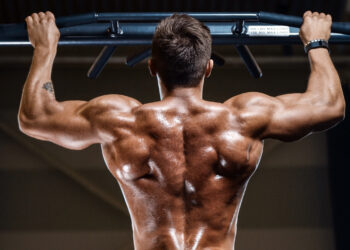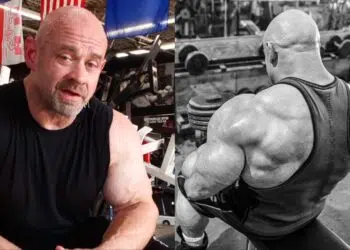When writing their workouts, a lot of trainers like to include a long list of exercises to work the target muscles from every conceivable angle. They then prescribe set after set for each exercise, creating a program that can take a couple of hours to complete.
While such an approach sometimes works, it’s usually unnecessary for typical, drug-free lifters. In fact, long, complex routines are often hard to stick to, as inconvenience frequently outweighs any potential benefits. After all, lack of time and access to facilities are two very common barriers to consistent exercise (1).
That’s why, as a veteran personal trainer with over three decades of experience, I tend to write shorter programs that emphasize just a few basic lifts. Most of my clients prefer this more minimalist approach, and missed workouts are a rarity.
This program writing philosophy is based on something called the Pareto Principle, or the 80/20 rule as it’s often known. This rule states that you get 80% of your results from 20% of your effort. In short, more exercises or longer workouts do not provide substantially better results.
With all that in mind, in this article I reveal the only three exercises you need to build a thick, wide, strong back. Sure, there are plenty of other exercises you can do for your back, but, in my opinion, these three provide the biggest bang for your buck. I’ve also provided a no-frills workout for you to try.
Back Anatomy Basics
Your back comprises several critical muscles, and they all deserve your attention if you want to build width, thickness, and strength. That said, in this section, I’ll boil down that long list of muscles to those that are arguably the most important.
Level Up Your Fitness: Join our 💪 strong community in Fitness Volt Newsletter. Get daily inspiration, expert-backed workouts, nutrition tips, the latest in strength sports, and the support you need to reach your goals. Subscribe for free!
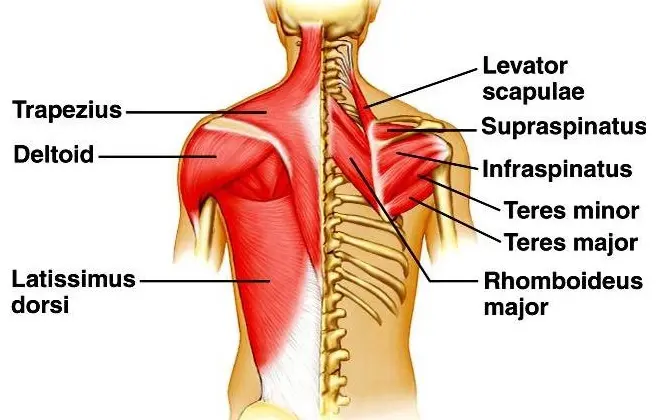
Latissimus Dorsi
Known as the lats for short, these muscles are located on the side of your mid and upper back. They’re essentially your wings and, when well-developed, are visible from the front and the rear of your body. If you want a massive “lat spread,” you MUST develop your lats!
Teres Major/Minor
Teres major and minor are your “mini lats.” Located just below your armpits, these muscles work with your latissimus dorsi and share many of the same functions. Developing these muscles will increase upper back width, contributing to that all-important V-taper.
Trapezius
Located across your upper back, the trapezius or traps is a large diamond-shaped muscle comprising three groups of fibers – upper, middle, and lower.
The upper fibers elevate or raise your shoulder girdle, while the middle fibers retract it, pulling your shoulder blades together. The lower fibers depress or pull your shoulder girdle downward. Your traps, especially the middle fibers, give your upper back its thickness.
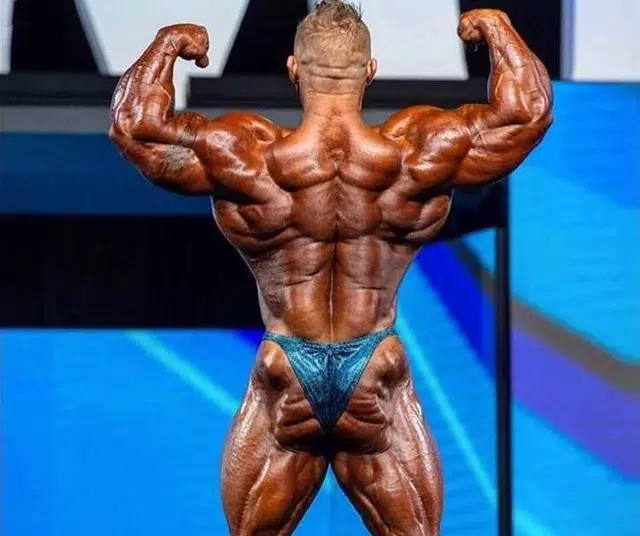
Rhomboids
The rhomboids are located between your scapulae or shoulder blades. Working with your mid-traps, their primary job is pulling your shoulder blades back and together in retraction. Like the mid-traps, the rhomboids contribute to upper back thickness.
Posterior Deltoids
No, I haven’t included this muscle by mistake! I consider the posterior deltoid a back muscle despite being part of your shoulders. Because it’s on the back of your body, it contributes to the size and shape of your back musculature. As such, you should always work your rear delts whenever you train the rest of your back. Thankfully, most back exercises also work your rear delts.
Erector Spinae
Running up either side of your back, the erector spinae muscles are responsible for extending, laterally flexing, and stabilizing your spine. Well-developed spinal erectors add a lot to the shape and size of your back. They also provide your spine with much-needed support, potentially lowering your risk of back pain and injury.
Now you know the basics of back anatomy, let’s move on to those essential back-building exercises!
Three Essential Exercises for a Muscular Back
While there are plenty of back-building exercises to choose from, in my opinion, these three offer the biggest bang for your training buck. Building your workouts around these essential moves is all but guaranteed to add mass to your lats, traps, rhomboids, and spinal erectors.
1. Sweeping Deadlift
The deadlift is arguably the most productive exercise you can do with a barbell. Sure, squats are called the king of exercises, but I believe deadlifts deserve that royal title. There are lots of deadlift variations, and they’re all excellent back builders. However, in my experience, sweeping deadlifts are the ultimate exercise for developing a picture-perfect back.
Steps:
- Load your barbell with an appropriate weight. Attach one end of a resistance band to the center of your barbell and fix the other to an immovable, e.g., a heavy dumbbell, squat rack, dumbbell rack, etc.
- Stand behind your bar, feet hip-width apart.
- Reach down and hold the barbell with a shoulder-width double overhand grip. Roll the bar toward your shins to engage your lats.
- Straighten your arms, brace your core, and pull your shoulders down and back. Drop your hips so they’re lower than your shoulders.
- Drive your feet into the floor and stand up. Use your lats to keep the bar pressed back toward your legs.
- Pause in the upright position and tense your lats as hard as possible.
- Bend your knees, push your hips back, and lower the bar to the floor. Maintain lat engagement by continuing to press the bar back toward your legs.
- Reset your core and grip, and repeat.
Tips:
Level Up Your Fitness: Join our 💪 strong community in Fitness Volt Newsletter. Get daily inspiration, expert-backed workouts, nutrition tips, the latest in strength sports, and the support you need to reach your goals. Subscribe for free!
- Avoid rounding your lower back, as doing so increases your risk of injury.
- Chalk your hands to stop them slipping. Alternatively, use lifting straps to reinforce your grip.
- Don’t go too heavy. Instead, use a moderate weight so you can focus on keeping your lats engaged.
- Use two bands positioned a few feet apart if the bar turns as you lift it.
- Roll the barbell backward to make this exercise harder or forward to make it easier.
2. McGill Pull-Ups
While there is nothing wrong with lat pulldowns, pull-ups are by far the superior back-building exercise. That said, while there is no denying the power of pull-ups, there is more than one way to perform them.
The McGill pull-up, also known as the Pavel pull-up, involves a very explosive movement. Reps are usually done singularly or in pairs rather than extended sets. This exercise targets the fast twitch type IIb fibers that give your muscles most of their size.
Steps:
- Hang from an overhead bar with an overhand, shoulder-width grip.
- Pull your shoulders back and down and brace your core.
- Without kicking or swinging, pull your chest up to the bar as powerfully as possible. Really explode upward!
- Descend under control and then drop from the bar to rest for 10-15 seconds.
- Remount the bar and repeat.
Tips:
- Use a thumbless grip to reduce biceps engagement and emphasize your lats.
- Use lifting straps if your grip fails before the target muscles.
- Pull as hard as you can; see how high you can lift your chest above the bar.
- Drive your elbows down and back as hard as possible to maximize lat and trap engagement.
- Start each rep from a dead hang. Do not initiate the movement with a swing, kick, or kip.
Related: Pull-Ups Vs. Chin-Ups – Which One is Right for You?
3. Single-Arm Pendlay Rows
Where vertical pulling exercises like pull-ups and pulldowns primarily build back width, horizontal pulls (rows) build back thickness. As such, all good back-building workouts need to include both. Barbell Pendlay or dead-stop rows are one of the safest, most effective horizontal pulling exercises around, and doing them with a single dumbbell makes them even better!
Steps:
- Place a single dumbbell on the floor and stand slightly behind it so it’s just inside your right foot.
- Stand with your feet a little wider than shoulder-width apart.
- Lean forward and hold the dumbbell so your palm faces inward, i.e., a neutral grip.
- Your torso should be parallel to the floor, and your lower back should be slightly arched. Tense your core and adjust the angle of your knees and hips to achieve this position.
- Leading with your elbows, smoothly pull the dumbbell off the floor and up and into the side of your ribcage.
- Lower the dumbbell back to the floor and allow it to settle for 1-2 seconds.
- Reset your grip and core, and repeat.
Tips:
- Do not use your legs or back to help you lift the weight. Instead, focus on driving your elbow back to maximize lat engagement.
- Make sure you do the same number of reps with both arms.
- Keep your wrists straight to avoid shortening your range of motion.
- Chalk your hands to stop sweaty palms bringing your set to a premature end.
- You can also do this exercise with one knee and hand resting on a bench:
Simple but Effective Back Building Workout
Adding any of these exercises to your training will make your back workouts more effective. However, you’ll probably get better results if you use them in a more structured way. Here is a tried and tested back-building workout that only uses these three awesome exercises.
Do it 1-2 times a week on non-consecutive days, e.g., On Monday, or Tuesday and Friday. Feel free to train your biceps once you’re finished working your back.
But, before you start, make sure you prepare your muscles and joints with a thorough warm-up. Begin with 5-10 minutes of cardio, e.g., a rower, elliptical, or air bike, and then do a few minutes of dynamic mobility and flexibility exercises for your elbows, shoulders, and lower back. Finish off with 1-3 light sets of the first exercise.
| Exercise | Sets | Reps | Recovery | |
| 1 | Sweeping Deadlift | 5 | 5* | 2-3 minutes |
| 2 | Single-Arm Pendlay Rows | 4 | 10-12 per arm | 1-2 minutes |
| 3 | McGill Pull-Ups | 3 | 6-8** | 1-2 minutes |
*Use light to moderate weights for the first two sets, then go heavier for the final three.
**Do reps singularly or in pairs. End your set when you can no longer maintain the same speed/power.
Conclusion
While the chest and biceps are the upper body muscles every exerciser wants to focus on, your back probably deserves more of your attention. A well-developed back is visible from every angle and adds a huge amount to your overall physique. Wide, thick backs look powerful and will earn you admiring glances from lifters and non-lifters alike.
However, it takes more than a few sets of lat pulldowns and seated rows to sculpt the perfect back. Building a back you can be proud of requires effort, consistency, and the right exercises.
There are dozens of well-known back exercises to choose from. But, as a 30-year veteran personal trainer, I put sweeping deadlifts, McGill pull-ups, and single-arm Pendlay rows at the top of the list.
Add these exercises to your existing training plan or, better yet, do them exclusively for the next couple of months, and your back will grow faster than ever before.
Next read: 15 Best Back Exercises For Bigger, Stronger, And Pain-Free Back
References
- Koh YS, Asharani PV, Devi F, Roystonn K, Wang P, Vaingankar JA, Abdin E, Sum CF, Lee ES, Müller-Riemenschneider F, Chong SA, Subramaniam M. A cross-sectional study on the perceived barriers to physical activity and their associations with domain-specific physical activity and sedentary behavior. BMC Public Health. 2022 May 26;22(1):1051. doi: 10.1186/s12889-022-13431-2. PMID: 35614402; PMCID: PMC9132675.



